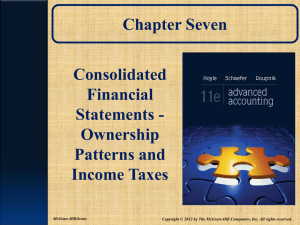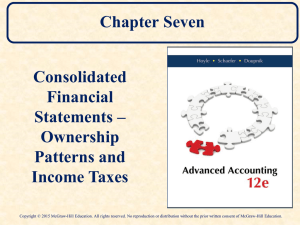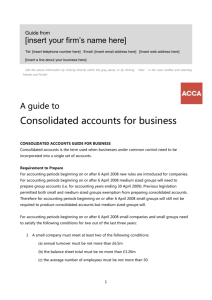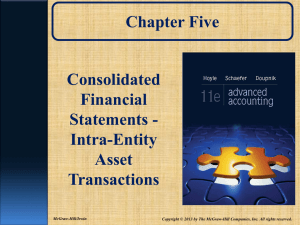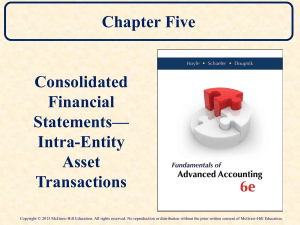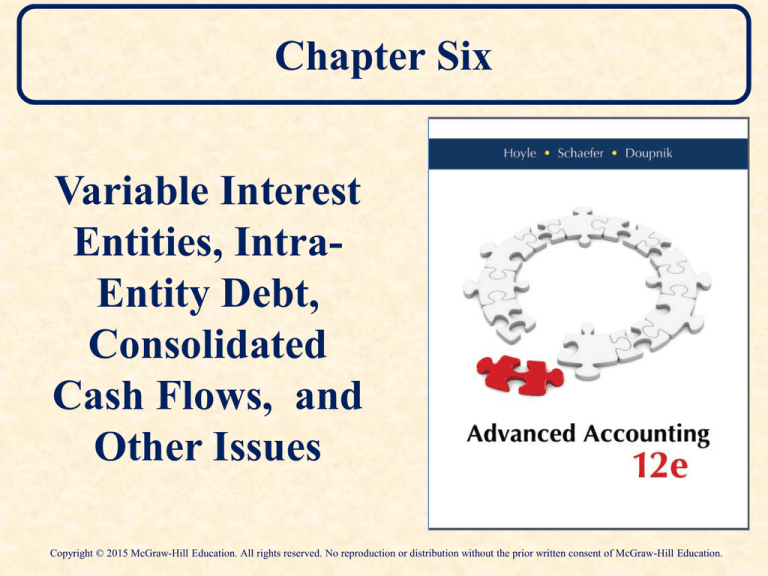
Chapter Six
Variable Interest
Entities, IntraEntity Debt,
Consolidated
Cash Flows, and
Other Issues
Copyright © 2015 McGraw-Hill Education. All rights reserved. No reproduction or distribution without the prior written consent of McGraw-Hill Education.
Variable Interest Entities (VIE’s)
Learning Objective 6-1:
Describe a variable interest entity, a primary beneficiary, and
the factors used to decide when a variable interest entity is subject
to consolidation.
Known as Special Purpose Entities (SPE)
Established as a separate business structure
– Trust
– Partnership
- Joint Venture
- Corporation
Frequently has neither independent management nor employees
Typical purposes
– help finance their operations at favorable rates
– Transfers of financial assets
- Leasing
– Hedging financial instruments
- Research and development
Off-balance sheet financing
6-2
Variable Interest Entities (VIE’s)
Examples of Variable Interests
6-3
Intra-Entity Debt Transactions
Learning Objective 6-2:
Demonstrate the consolidation procedures to eliminate all intraentity debt accounts and recognize any associated gain or loss
created whenever one company acquires an affiliate’s debt
instrument from an outside party.
A company CANNOT lend money to itself.
Intra-entity investments in debt securities and related debt
accounts must be eliminated in consolidation despite their
differing balances.
Corresponding receivable and payable and revenue and interest
from the consolidated financial statements must be eliminated.
6-4
Intra-Entity Debt Transactions - Example
Gain/loss on effective retirement of the debt must be recognized
in the consolidated statements.
Alpha owns 80% of Omega. On 1/1/12, Omega issued $1 million
in 10-year bonds at 9%. Omega issued the bonds at $938,555,
with effective interest at 10%. On 1/1/14, Alpha purchased the
bonds for $1,057,466, with effective interest at 8%. Book value of
Omega Company’s bonds as of December 31, 2013, the date
before Alpha Company acquired the bonds.
6-5
Intra-Entity Debt Transactions Example
Omega records only two journal entries during 2014
assuming interest is paid each December 31to record the
interest expense cash payment and discount on bonds
payable.
6-6
Intra-Entity Debt Transactions Example
In 2014, Alpha records its investment in
Omega’s bonds and the interest income.
6-7
Intra-Entity Debt Transactions Example
To convert information from the individual companies to the
perspective of a single economic entity, we extinguish the debt (it is
no longer owed to a third-party). Any gains/losses are attributed
to the parent, thus, there is no effect on Noncontrolling Interest.
6-8
Intra-Entity Debt Transactions Example
Subsequent Years - Initial Value or Partial Equity Method
Adjust the BV’s of the Bonds Payable and the Investment in
Bonds to reflect amortization with Entry *B. Also, the loss is now
reflected in R/E, which must be adjusted for the difference in
interest amounts.
6-9
Intra-Entity Debt Transactions Example
Subsequent Years –Equity Method
Adjust the BV’s of the Bonds Payable and the Investment in
Bonds to reflect amortization with Entry *B. Also, the loss is now
reflected in R/E, which must be adjusted for the difference in
interest amounts.
6-10
Subsidiary Preferred Stock
Learning Objective 6-3:
Understand that subsidiary preferred stocks not owned by
the parent are a component of the noncontrolling interest
and are initially measured at acquisition-date fair value.
Preferred stock, usually nonvoting, possess “preferences”
over common shares such as cumulative dividends,
participation rights, and sometimes limited voting rights.
They are part of the sub’s stockholders’ equity, treated in
consolidation similarly to common.
Existence of subsidiary preferred shares does not complicate
the process. The acquisition method values all business
acquisitions (whether 100 percent or less) at full fair values.
6-11
Subsidiary Preferred Stock - Example The consolidation entry made in the year of
acquisition is shown below:
6-12
Consolidated Statement of Cash Flows
Learning Objective 6-4:
Prepare a consolidated statement of cash flows.
Current accounting standards require that companies include
a statement of cash flows among their consolidated financial
reports.
The main purpose of the statement of cash flows is to provide
information about the entity’s cash receipts and cash
payments during a period.
The consolidated statement of cash flows is based on the
consolidated balance sheet and the consolidated income
statement.
6-13
Consolidated Statement of Cash Flows
Intra-entity cash flows should not be included on the statement
of cash flows. Intra-entity cash flows are already eliminated
from the balance sheet, so no additional effects appear on the
statement of cash flows.
In the year of acquisition, net cash outflow (cash paid less
subsidiary cash acquired) to acquire the subsidiary is reported.
Any amounts acquired are not included in the increase or
decrease of balance sheet accounts.
In all years, add back noncontrolling interest’s share of the
sub’s net income.
Deduct dividends paid to outside owners as cash outflow.
6-14
Consolidated Earnings Per Share
Learning Objective 6-5:
Compute basic and diluted earnings per share for a business
combination.
Computing EPS for a business combination follows the general rules.
Consolidated net income attributable to the parent company owners
along with the number of outstanding parent shares provides the
basis for calculating basic EPS.
Any convertibles, warrants, or options for the parent’s stock that can
possibly dilute the reported figure must be included in diluted EPS.
6-15
Consolidated Earnings Per Share
If potentially dilutive items exist on the sub’s individual
statements, then the portion of the sub’s net income included in
consolidated net income may not be appropriate for the
computation of consolidated earnings per share.
EPS
=
Net
Income
÷
Weighted Average
Common Shares
Outstanding
‣ Compute the sub’s own diluted EPS.
‣Earnings used in the computation are used to determine
consolidated EPS.
‣ Portion assigned to the computation is based on the percent
of the subsidiary owned by the parent.
6-16
Subsidiary Stock Transactions
Learning Objective 6-6:
Demonstrate the accounting effects of subsidiary stock
transactions on parent’s financial records and consolidated
financial statements.
A parent’s ownership percentage may be affected by a
subsidiary’s transactions in its own stock (additional
issuances, or the purchase or treasury stock).
The effects on the consolidated entity are recorded by the
parent as an adjustment to APIC and the investment
account.
Not reported as a gain or loss of the consolidated entity.
6-17


